differential MITSUBISHI L200 2018 (in English) User Guide
[x] Cancel search | Manufacturer: MITSUBISHI, Model Year: 2018, Model line: L200, Model: MITSUBISHI L200 2018Pages: 466, PDF Size: 28.42 MB
Page 166 of 466
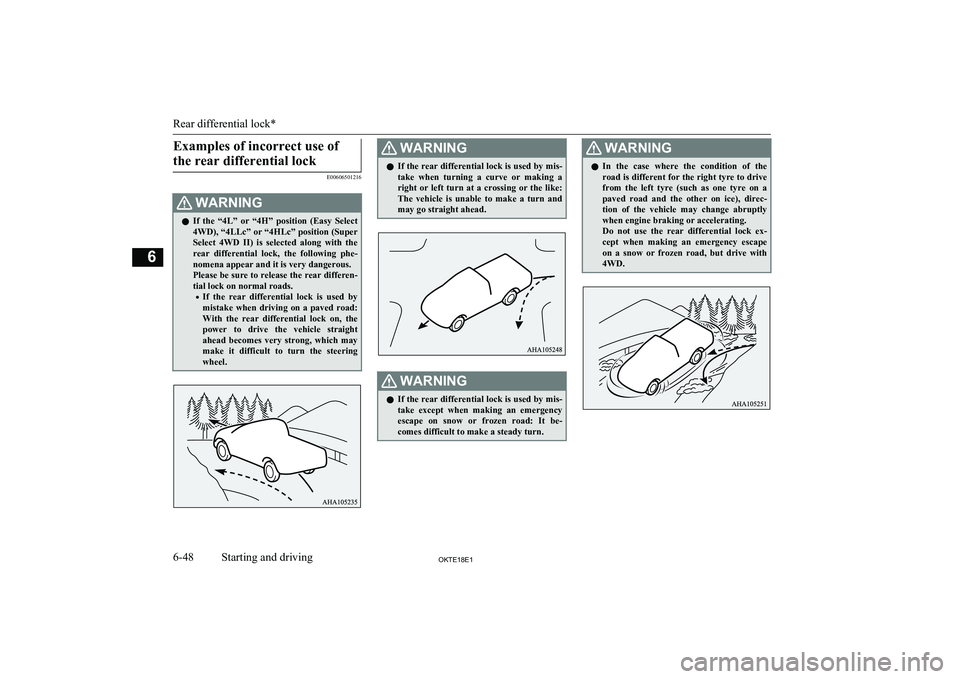
Examples of incorrect use ofthe rear differential lock
E00606501216
WARNINGl If the “4L” or “4H” position (Easy Select
4WD), “4LLc” or “4HLc” position (Super
Select 4WD II) is selected along with the rear differential lock, the following phe-nomena appear and it is very dangerous.
Please be sure to release the rear differen-
tial lock on normal roads.
• If the rear differential lock is used by
mistake when driving on a paved road:
With the rear differential lock on, the power to drive the vehicle straight
ahead becomes very strong, which may make it difficult to turn the steering
wheel.WARNINGl If the rear differential lock is used by mis-
take when turning a curve or making a
right or left turn at a crossing or the like:
The vehicle is unable to make a turn and may go straight ahead.WARNINGl If the rear differential lock is used by mis-
take except when making an emergencyescape on snow or frozen road: It be-
comes difficult to make a steady turn.WARNINGl In the case where the condition of the
road is different for the right tyre to drive
from the left tyre (such as one tyre on a paved road and the other on ice), direc- tion of the vehicle may change abruptly
when engine braking or accelerating.
Do not use the rear differential lock ex-
cept when making an emergency escape on a snow or frozen road, but drive with
4WD.
Rear differential lock*
6-48OKTE18E1Starting and driving6
Page 167 of 466
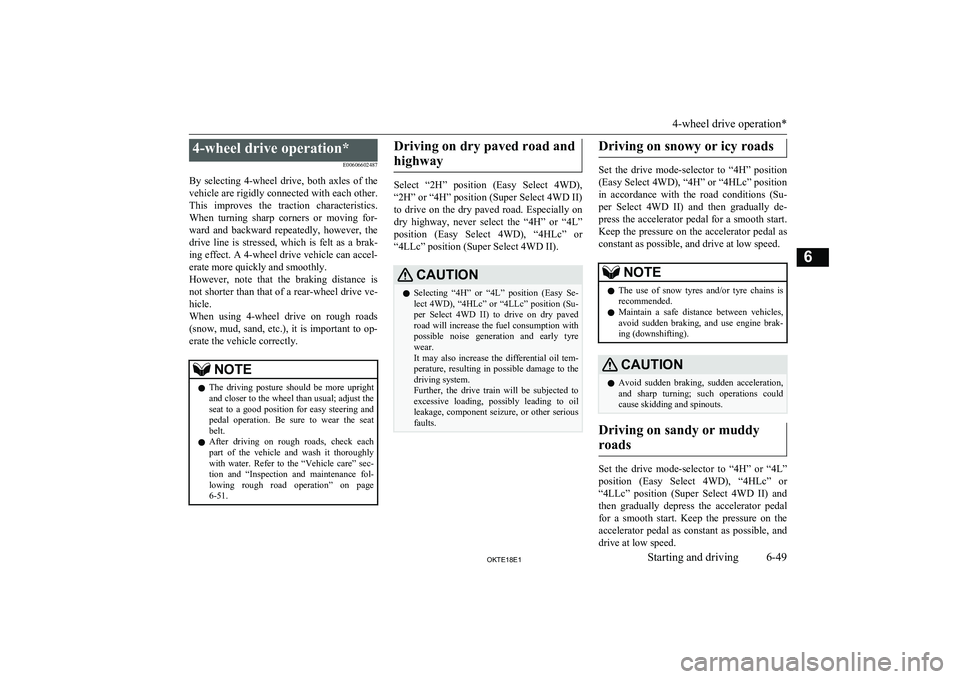
4-wheel drive operation*E00606602487
By selecting 4-wheel drive, both axles of the
vehicle are rigidly connected with each other. This improves the traction characteristics. When turning sharp corners or moving for-
ward and backward repeatedly, however, the drive line is stressed, which is felt as a brak-
ing effect. A 4-wheel drive vehicle can accel-
erate more quickly and smoothly.
However, note that the braking distance is not shorter than that of a rear-wheel drive ve-hicle.
When using 4-wheel drive on rough roads
(snow, mud, sand, etc.), it is important to op- erate the vehicle correctly.NOTEl The driving posture should be more upright
and closer to the wheel than usual; adjust the
seat to a good position for easy steering and pedal operation. Be sure to wear the seatbelt.
l After driving on rough roads, check each
part of the vehicle and wash it thoroughlywith water. Refer to the “Vehicle care” sec-
tion and “Inspection and maintenance fol-
lowing rough road operation” on page 6-51.Driving on dry paved road and
highway
Select “2H” position (Easy Select 4WD),
“2H” or “4H” position (Super Select 4WD II) to drive on the dry paved road. Especially on
dry highway, never select the “4H” or “4L”
position (Easy Select 4WD), “4HLc” or “4LLc” position (Super Select 4WD II).
CAUTIONl Selecting “4H” or “4L” position (Easy Se-
lect 4WD), “4HLc” or “4LLc” position (Su-
per Select 4WD II) to drive on dry paved
road will increase the fuel consumption with possible noise generation and early tyrewear.
It may also increase the differential oil tem- perature, resulting in possible damage to the
driving system.
Further, the drive train will be subjected to excessive loading, possibly leading to oil
leakage, component seizure, or other serious faults.Driving on snowy or icy roads
Set the drive mode-selector to “4H” position
(Easy Select 4WD), “4H” or “4HLc” position in accordance with the road conditions (Su-
per Select 4WD II) and then gradually de-
press the accelerator pedal for a smooth start. Keep the pressure on the accelerator pedal asconstant as possible, and drive at low speed.
NOTEl The use of snow tyres and/or tyre chains is
recommended.
l Maintain a safe distance between vehicles,
avoid sudden braking, and use engine brak-
ing (downshifting).CAUTIONl Avoid sudden braking, sudden acceleration,
and sharp turning; such operations could
cause skidding and spinouts.
Driving on sandy or muddy
roads
Set the drive mode-selector to “4H” or “4L”
position (Easy Select 4WD), “4HLc” or “4LLc” position (Super Select 4WD II) and then gradually depress the accelerator pedal
for a smooth start. Keep the pressure on the accelerator pedal as constant as possible, and drive at low speed.
4-wheel drive operation*
6-49OKTE18E1Starting and driving6
Page 170 of 466
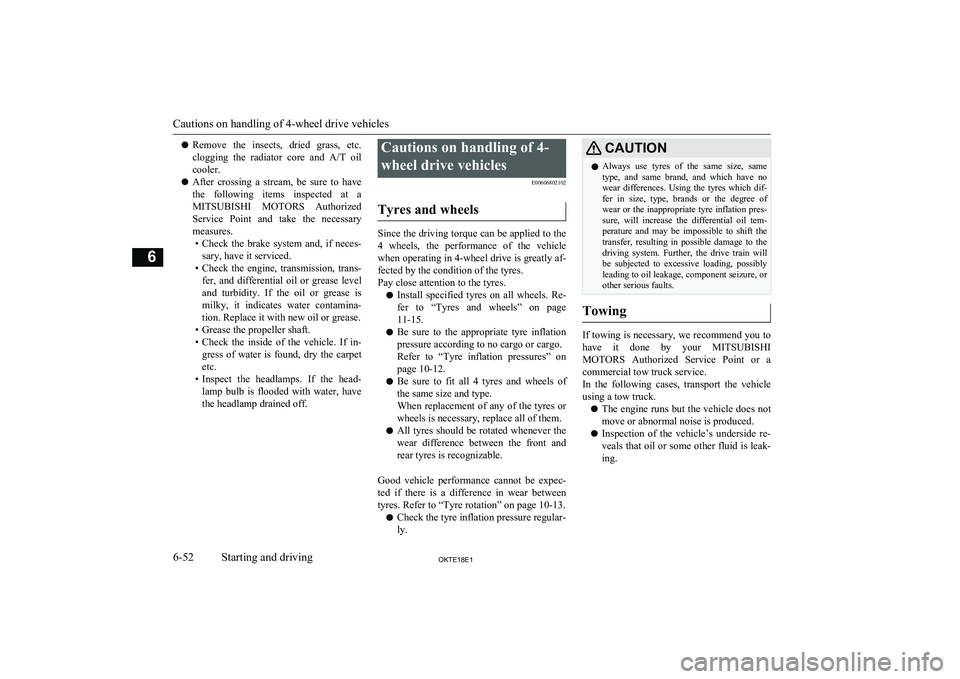
lRemove the insects, dried grass, etc.
clogging the radiator core and A/T oil
cooler.
l After crossing a stream, be sure to have
the following items inspected at a MITSUBISHI MOTORS Authorized
Service Point and take the necessary
measures. • Check the brake system and, if neces-
sary, have it serviced.
• Check the engine, transmission, trans-
fer, and differential oil or grease level and turbidity. If the oil or grease is
milky, it indicates water contamina-
tion. Replace it with new oil or grease.
• Grease the propeller shaft.
• Check the inside of the vehicle. If in-
gress of water is found, dry the carpetetc.
• Inspect the headlamps. If the head-
lamp bulb is flooded with water, have
the headlamp drained off.Cautions on handling of 4-
wheel drive vehicles E00606802102
Tyres and wheels
Since the driving torque can be applied to the 4 wheels, the performance of the vehiclewhen operating in 4-wheel drive is greatly af-
fected by the condition of the tyres.
Pay close attention to the tyres.
l Install specified tyres on all wheels. Re-
fer to “Tyres and wheels” on page 11-15.
l Be sure to the appropriate tyre inflation
pressure according to no cargo or cargo.
Refer to “Tyre inflation pressures” on
page 10-12.
l Be sure to fit all 4 tyres and wheels of
the same size and type.
When replacement of any of the tyres or wheels is necessary, replace all of them.
l All tyres should be rotated whenever the
wear difference between the front and
rear tyres is recognizable.
Good vehicle performance cannot be expec-
ted if there is a difference in wear between tyres. Refer to “Tyre rotation” on page 10-13.
l Check the tyre inflation pressure regular-
ly.
CAUTIONl Always use tyres of the same size, same
type, and same brand, and which have no wear differences. Using the tyres which dif-
fer in size, type, brands or the degree of wear or the inappropriate tyre inflation pres-
sure, will increase the differential oil tem- perature and may be impossible to shift the transfer, resulting in possible damage to the
driving system. Further, the drive train will be subjected to excessive loading, possibly
leading to oil leakage, component seizure, or
other serious faults.
Towing
If towing is necessary, we recommend you to
have it done by your MITSUBISHI
MOTORS Authorized Service Point or a
commercial tow truck service.
In the following cases, transport the vehicle
using a tow truck.
l The engine runs but the vehicle does not
move or abnormal noise is produced.
l Inspection of the vehicle’s underside re-
veals that oil or some other fluid is leak- ing.
Cautions on handling of 4-wheel drive vehicles
6-52OKTE18E1Starting and driving6
Page 175 of 466
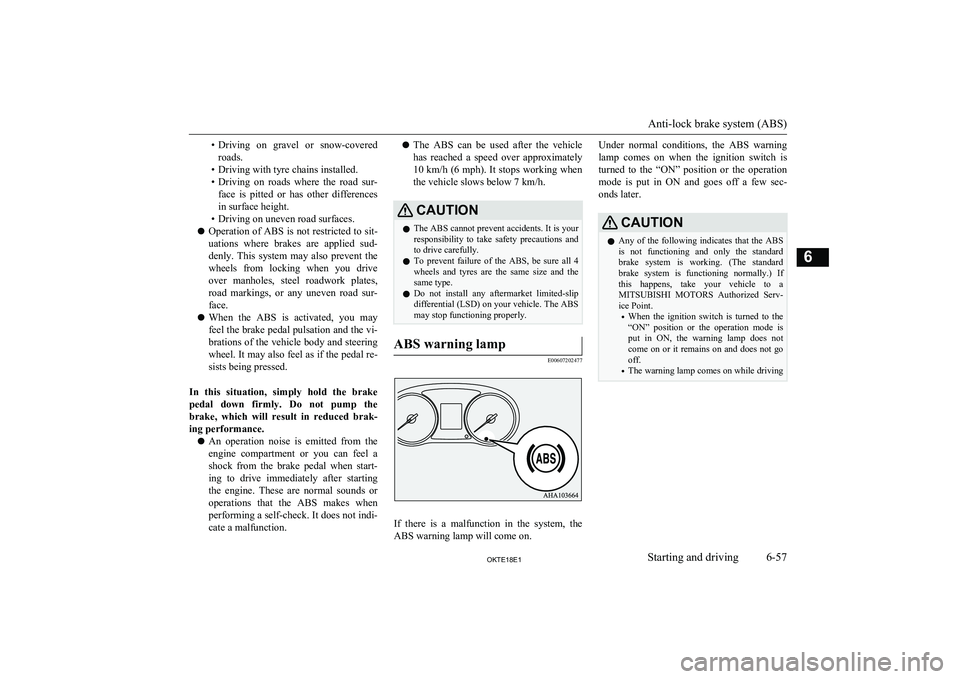
•Driving on gravel or snow-covered
roads.
• Driving with tyre chains installed.
• Driving on roads where the road sur-
face is pitted or has other differences in surface height.
• Driving on uneven road surfaces.
l Operation of ABS is not restricted to sit-
uations where brakes are applied sud-denly. This system may also prevent the
wheels from locking when you drive over manholes, steel roadwork plates,
road markings, or any uneven road sur-
face.
l When the ABS is activated, you may
feel the brake pedal pulsation and the vi-
brations of the vehicle body and steering
wheel. It may also feel as if the pedal re- sists being pressed.
In this situation, simply hold the brake
pedal down firmly. Do not pump the
brake, which will result in reduced brak- ing performance.
l An operation noise is emitted from the
engine compartment or you can feel a shock from the brake pedal when start-
ing to drive immediately after starting
the engine. These are normal sounds or operations that the ABS makes whenperforming a self-check. It does not indi-
cate a malfunction.l The ABS can be used after the vehicle
has reached a speed over approximately 10 km/h (6 mph). It stops working when the vehicle slows below 7 km/h.CAUTIONl The ABS cannot prevent accidents. It is your
responsibility to take safety precautions and to drive carefully.
l To prevent failure of the ABS, be sure all 4
wheels and tyres are the same size and the same type.
l Do not install any aftermarket limited-slip
differential (LSD) on your vehicle. The ABS may stop functioning properly.ABS warning lamp
E00607202477
If there is a malfunction in the system, the
ABS warning lamp will come on.
Under normal conditions, the ABS warning
lamp comes on when the ignition switch is
turned to the “ON” position or the operation mode is put in ON and goes off a few sec-
onds later.CAUTIONl Any of the following indicates that the ABS
is not functioning and only the standard
brake system is working. (The standard brake system is functioning normally.) If
this happens, take your vehicle to a
MITSUBISHI MOTORS Authorized Serv-
ice Point.
• When the ignition switch is turned to the
“ON” position or the operation mode is
put in ON, the warning lamp does not come on or it remains on and does not go off.
• The warning lamp comes on while driving
Anti-lock brake system (ABS)
6-57OKTE18E1Starting and driving6
Page 176 of 466
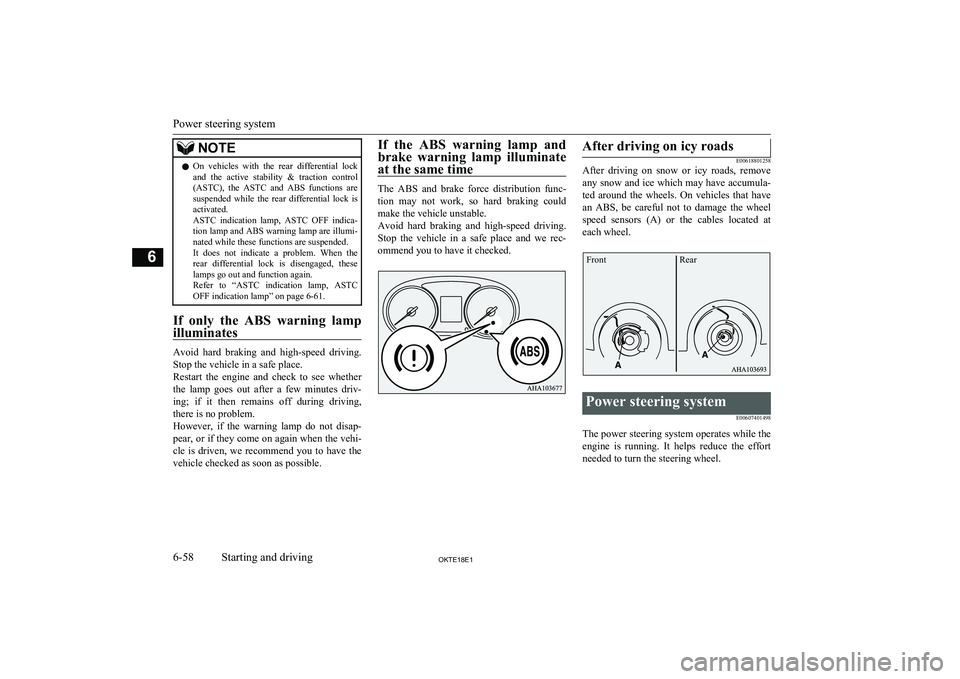
NOTElOn vehicles with the rear differential lock
and the active stability & traction control
(ASTC), the ASTC and ABS functions are suspended while the rear differential lock isactivated.
ASTC indication lamp, ASTC OFF indica-
tion lamp and ABS warning lamp are illumi- nated while these functions are suspended.
It does not indicate a problem. When the
rear differential lock is disengaged, these lamps go out and function again.
Refer to “ASTC indication lamp, ASTC
OFF indication lamp” on page 6-61.
If only the ABS warning lamp
illuminates
Avoid hard braking and high-speed driving.
Stop the vehicle in a safe place.
Restart the engine and check to see whether the lamp goes out after a few minutes driv-
ing; if it then remains off during driving,
there is no problem.
However, if the warning lamp do not disap- pear, or if they come on again when the vehi-cle is driven, we recommend you to have the vehicle checked as soon as possible.
If the ABS warning lamp and
brake warning lamp illuminate at the same time
The ABS and brake force distribution func-tion may not work, so hard braking could
make the vehicle unstable.
Avoid hard braking and high-speed driving.
Stop the vehicle in a safe place and we rec- ommend you to have it checked.
After driving on icy roads
E00618801258
After driving on snow or icy roads, remove
any snow and ice which may have accumula-
ted around the wheels. On vehicles that have
an ABS, be careful not to damage the wheel
speed sensors (A) or the cables located at each wheel.Power steering system
E00607401498
The power steering system operates while the
engine is running. It helps reduce the effort needed to turn the steering wheel.
Power steering system
6-58OKTE18E1Starting and driving6 Front Rear
Page 177 of 466
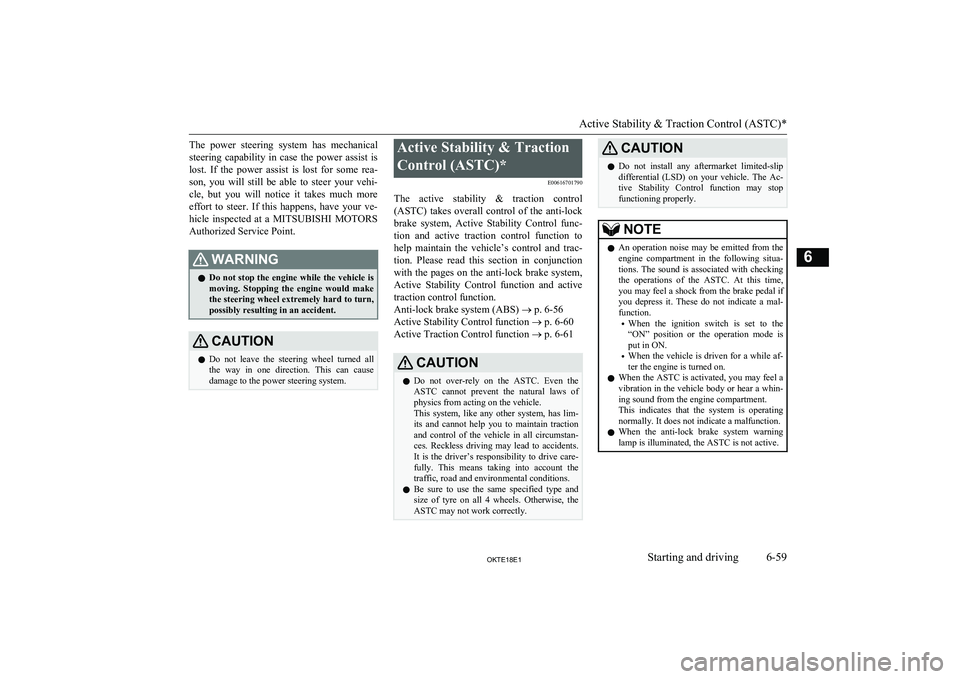
The power steering system has mechanical
steering capability in case the power assist is lost. If the power assist is lost for some rea-
son, you will still be able to steer your vehi-
cle, but you will notice it takes much more effort to steer. If this happens, have your ve-hicle inspected at a MITSUBISHI MOTORS
Authorized Service Point.WARNINGl Do not stop the engine while the vehicle is
moving. Stopping the engine would make the steering wheel extremely hard to turn,
possibly resulting in an accident.CAUTIONl Do not leave the steering wheel turned all
the way in one direction. This can causedamage to the power steering system.Active Stability & Traction
Control (ASTC)* E00616701790
The active stability & traction control (ASTC) takes overall control of the anti-lockbrake system, Active Stability Control func-
tion and active traction control function to
help maintain the vehicle’s control and trac- tion. Please read this section in conjunction with the pages on the anti-lock brake system,
Active Stability Control function and active
traction control function.
Anti-lock brake system (ABS) ® p. 6-56
Active Stability Control function ® p. 6-60
Active Traction Control function ® p. 6-61CAUTIONl Do not over-rely on the ASTC. Even the
ASTC cannot prevent the natural laws of
physics from acting on the vehicle. This system, like any other system, has lim-
its and cannot help you to maintain traction and control of the vehicle in all circumstan- ces. Reckless driving may lead to accidents.
It is the driver’s responsibility to drive care- fully. This means taking into account the
traffic, road and environmental conditions.
l Be sure to use the same specified type and
size of tyre on all 4 wheels. Otherwise, the
ASTC may not work correctly.CAUTIONl Do not install any aftermarket limited-slip
differential (LSD) on your vehicle. The Ac-
tive Stability Control function may stop functioning properly.NOTEl An operation noise may be emitted from the
engine compartment in the following situa-
tions. The sound is associated with checking the operations of the ASTC. At this time,
you may feel a shock from the brake pedal if
you depress it. These do not indicate a mal- function.
• When the ignition switch is set to the
“ON” position or the operation mode is put in ON.
• When the vehicle is driven for a while af-
ter the engine is turned on.
l When the ASTC is activated, you may feel a
vibration in the vehicle body or hear a whin-
ing sound from the engine compartment.
This indicates that the system is operating normally. It does not indicate a malfunction.
l When the anti-lock brake system warning
lamp is illuminated, the ASTC is not active.
Active Stability & Traction Control (ASTC)*
6-59OKTE18E1Starting and driving6
Page 178 of 466
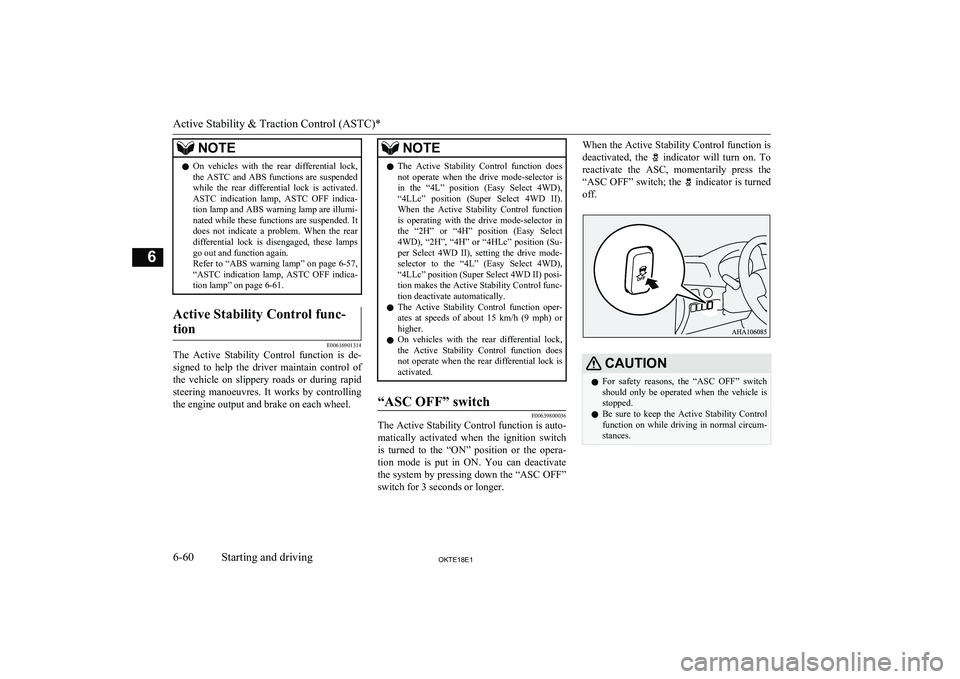
NOTElOn vehicles with the rear differential lock,
the ASTC and ABS functions are suspended
while the rear differential lock is activated. ASTC indication lamp, ASTC OFF indica-
tion lamp and ABS warning lamp are illumi- nated while these functions are suspended. It
does not indicate a problem. When the rear differential lock is disengaged, these lamps
go out and function again.
Refer to “ABS warning lamp” on page 6-57,
“ASTC indication lamp, ASTC OFF indica-
tion lamp” on page 6-61.Active Stability Control func-
tion
E00616901314
The Active Stability Control function is de- signed to help the driver maintain control of the vehicle on slippery roads or during rapid
steering manoeuvres. It works by controlling the engine output and brake on each wheel.
NOTEl The Active Stability Control function does
not operate when the drive mode-selector isin the “4L” position (Easy Select 4WD),“4LLc” position (Super Select 4WD II).
When the Active Stability Control function
is operating with the drive mode-selector in the “2H” or “4H” position (Easy Select
4WD), “2H”, “4H” or “4HLc” position (Su-
per Select 4WD II), setting the drive mode- selector to the “4L” (Easy Select 4WD), “4LLc” position (Super Select 4WD II) posi-
tion makes the Active Stability Control func-
tion deactivate automatically.
l The Active Stability Control function oper-
ates at speeds of about 15 km/h (9 mph) or
higher.
l On vehicles with the rear differential lock,
the Active Stability Control function does not operate when the rear differential lock is
activated.“ASC OFF” switch
E00639800036
The Active Stability Control function is auto-
matically activated when the ignition switchis turned to the “ON” position or the opera-
tion mode is put in ON. You can deactivate
the system by pressing down the “ASC OFF”
switch for 3 seconds or longer.
When the Active Stability Control function is
deactivated, the
indicator will turn on. To
reactivate the ASC, momentarily press the “ASC OFF” switch; the
indicator is turned
off.
CAUTIONl For safety reasons, the “ASC OFF” switch
should only be operated when the vehicle isstopped.
l Be sure to keep the Active Stability Control
function on while driving in normal circum-
stances.
Active Stability & Traction Control (ASTC)*
6-60OKTE18E1Starting and driving6
Page 361 of 466
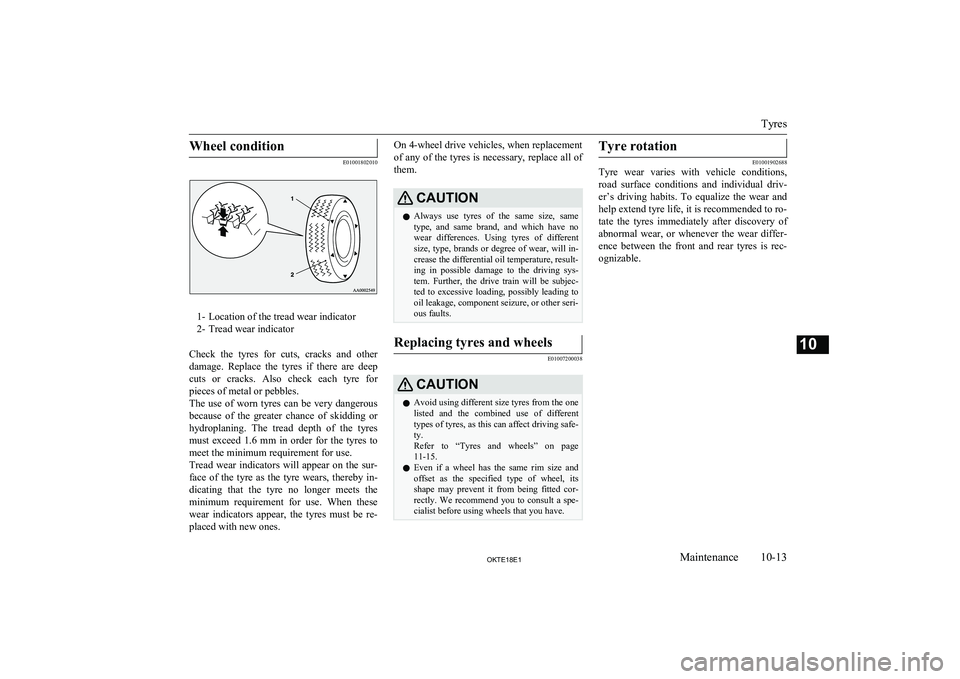
Wheel condition
E01001802010
1- Location of the tread wear indicator
2- Tread wear indicator
Check the tyres for cuts, cracks and other damage. Replace the tyres if there are deep
cuts or cracks. Also check each tyre for pieces of metal or pebbles.
The use of worn tyres can be very dangerous
because of the greater chance of skidding or
hydroplaning. The tread depth of the tyres
must exceed 1.6 mm in order for the tyres to meet the minimum requirement for use.
Tread wear indicators will appear on the sur-
face of the tyre as the tyre wears, thereby in-
dicating that the tyre no longer meets the
minimum requirement for use. When these wear indicators appear, the tyres must be re-
placed with new ones.
On 4-wheel drive vehicles, when replacement
of any of the tyres is necessary, replace all of
them.CAUTIONl Always use tyres of the same size, same
type, and same brand, and which have no wear differences. Using tyres of differentsize, type, brands or degree of wear, will in-
crease the differential oil temperature, result-
ing in possible damage to the driving sys-
tem. Further, the drive train will be subjec- ted to excessive loading, possibly leading tooil leakage, component seizure, or other seri-
ous faults.Replacing tyres and wheels
E01007200038
CAUTIONl Avoid using different size tyres from the one
listed and the combined use of different
types of tyres, as this can affect driving safe- ty.
Refer to “Tyres and wheels” on page
11-15.
l Even if a wheel has the same rim size and
offset as the specified type of wheel, its
shape may prevent it from being fitted cor- rectly. We recommend you to consult a spe-
cialist before using wheels that you have.Tyre rotation
E01001902688
Tyre wear varies with vehicle conditions,
road surface conditions and individual driv- er’s driving habits. To equalize the wear andhelp extend tyre life, it is recommended to ro-
tate the tyres immediately after discovery of
abnormal wear, or whenever the wear differ- ence between the front and rear tyres is rec-
ognizable.
Tyres
10-13OKTE18E1Maintenance10
Page 399 of 466
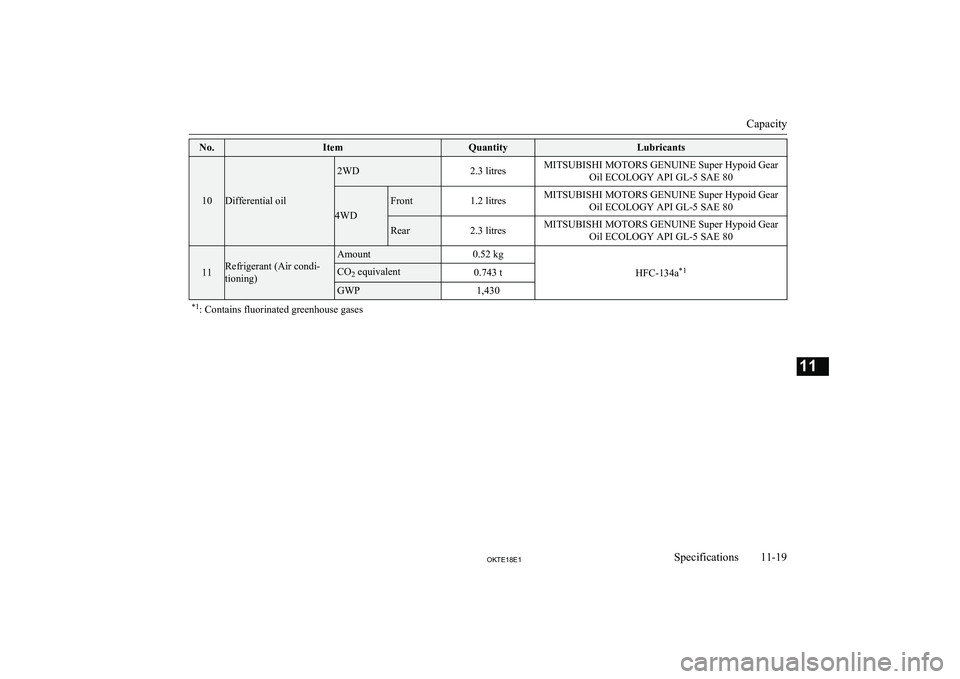
No.ItemQuantityLubricants
10Differential oil
2WD2.3 litresMITSUBISHI MOTORS GENUINE Super Hypoid GearOil ECOLOGY API GL-5 SAE 80
4WD
Front1.2 litresMITSUBISHI MOTORS GENUINE Super Hypoid GearOil ECOLOGY API GL-5 SAE 80Rear2.3 litresMITSUBISHI MOTORS GENUINE Super Hypoid GearOil ECOLOGY API GL-5 SAE 80
11Refrigerant (Air condi-
tioning)
Amount0.52 kg
HFC-134a *1
CO
2 equivalent0.743 tGWP1,430*1
: Contains fluorinated greenhouse gases
Capacity
11-19OKTE18E1Specifications11
Page 402 of 466
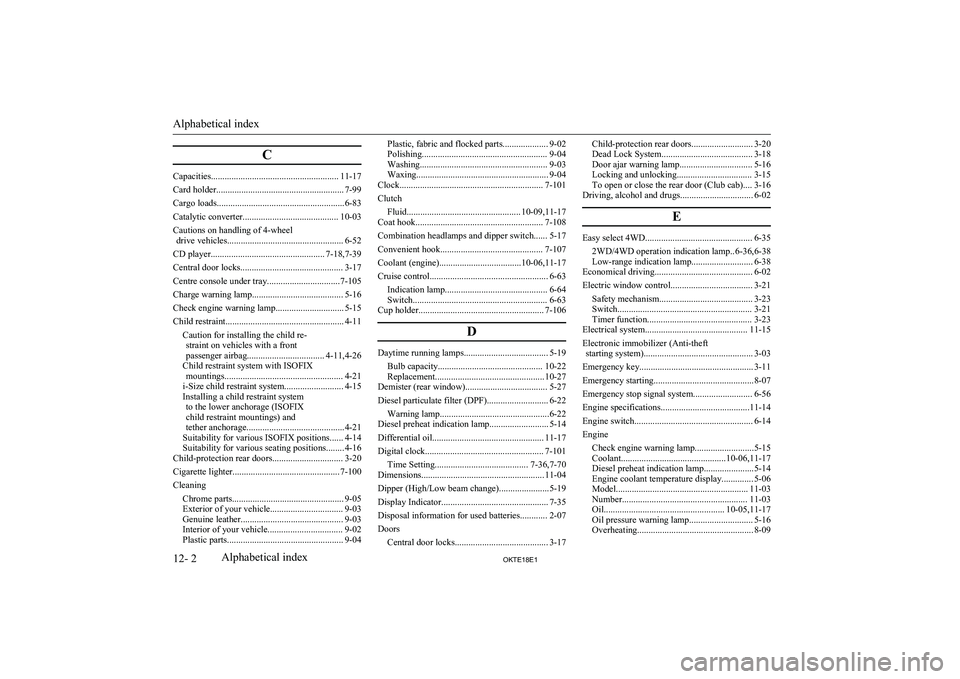
C
Capacities........................................................ 11-17
Card holder........................................................ 7-99
Cargo loads........................................................6-83
Catalytic converter.......................................... 10-03
Cautions on handling of 4-wheel drive vehicles................................................... 6-52
CD player.................................................. 7-18,7-39
Central door locks............................................. 3-17
Centre console under tray................................7-105
Charge warning lamp........................................ 5-16
Check engine warning lamp.............................. 5-15
Child restraint.................................................... 4-11 Caution for installing the child re-straint on vehicles with a front
passenger airbag.................................. 4-11,4-26
Child restraint system with ISOFIX mountings.................................................... 4-21
i-Size child restraint system.......................... 4-15
Installing a child restraint system to the lower anchorage (ISOFIX
child restraint mountings) and
tether anchorage...........................................4-21
Suitability for various ISOFIX positions...... 4-14
Suitability for various seating positions........ 4-16
Child-protection rear doors............................... 3-20
Cigarette lighter............................................... 7-100
Cleaning Chrome parts................................................. 9-05
Exterior of your vehicle................................ 9-03
Genuine leather............................................. 9-03
Interior of your vehicle................................. 9-02
Plastic parts................................................... 9-04
Plastic, fabric and flocked parts.................... 9-02
Polishing....................................................... 9-04
Washing........................................................ 9-03
Waxing.......................................................... 9-04
Clock............................................................... 7-101
Clutch Fluid.................................................. 10-09,11-17
Coat hook........................................................ 7-108
Combination headlamps and dipper switch...... 5-17
Convenient hook............................................. 7-107
Coolant (engine)....................................10-06,11-17
Cruise control.................................................... 6-63 Indication lamp............................................. 6-64
Switch........................................................... 6-63
Cup holder....................................................... 7-106
D
Daytime running lamps..................................... 5-19Bulb capacity.............................................. 10-22
Replacement................................................ 10-27
Demister (rear window).................................... 5-27
Diesel particulate filter (DPF)........................... 6-22 Warning lamp................................................6-22
Diesel preheat indication lamp.......................... 5-14
Differential oil................................................. 11-17
Digital clock.................................................... 7-101 Time Setting......................................... 7-36,7-70
Dimensions...................................................... 11-04
Dipper (High/Low beam change)......................5-19
Display Indicator............................................... 7-35
Disposal information for used batteries............ 2-07
Doors Central door locks......................................... 3-17
Child-protection rear doors........................... 3-20
Dead Lock System........................................ 3-18 Door ajar warning lamp................................ 5-16
Locking and unlocking................................. 3-15
To open or close the rear door (Club cab).... 3-16
Driving, alcohol and drugs................................ 6-02
E
Easy select 4WD............................................... 6-352WD/4WD operation indication lamp.. 6-36,6-38
Low-range indication lamp........................... 6-38
Economical driving........................................... 6-02
Electric window control.................................... 3-21 Safety mechanism......................................... 3-23
Switch........................................................... 3-21
Timer function.............................................. 3-23
Electrical system............................................. 11-15
Electronic immobilizer (Anti-theft starting system)................................................ 3-03
Emergency key.................................................. 3-11
Emergency starting............................................8-07
Emergency stop signal system.......................... 6-56
Engine specifications.......................................11-14
Engine switch.................................................... 6-14
Engine
Check engine warning lamp..........................5-15
Coolant..............................................10-06,11-17 Diesel preheat indication lamp......................5-14Engine coolant temperature display.............. 5-06
Model.......................................................... 11-03
Number....................................................... 11-03
Oil..................................................... 10-05,11-17
Oil pressure warning lamp............................ 5-16
Overheating................................................... 8-09
Alphabetical index
12- 2 OKTE18E1Alphabetical index